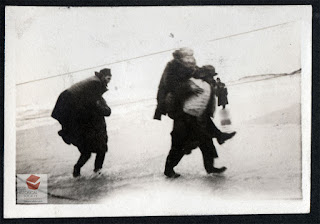If you were transported back to Corvallis, Oregon, in 1914, you might
recognize some of the buildings in this photograph of Second Street such as the
Benton County Bank Building (now Lucidyne offices) in the upper right.
 |
| 2nd Street Corvallis in 1914 |
Then, as now, Second Street was part of the main business
district. The women are standing by the
R. H. Huston hardware store. The Benton County Historical Museum does not have
a photo of the interior of that store. It
probably would have looked like that of the Cooper and Newton Hardware store,
also on Second Street, shown in this 1910 photo.
 |
| Cooper & Newton hardware store in 1910 |
The women might be headed toward the First National Bank
building on the southwest corner of Madison and Second Street.
 |
| First National Bank, Corvallis, Oregon |
Then they might use the cash to shop for groceries or
medicines. Kline's Grocery, show in this photograph from 1916-1918, was located
on Second Street, across from where the Odd Fellows Hall is now. In this old-style grocery, customers would
hand a clerk a shopping list or make a verbal request and the clerk would
retrieve the desired items from the shelves.
Meat would be purchased from a special store which operated
in a similar fashion. This photograph shows the interior of the Corvallis Meat
Market in 1922 or 1923.
 |
| Corvallis Meat Market |
Today, there are no grocery stores or meat markets on Second
Street-- you would have to walk a few blocks to the Safeway supermarket on
Third Street. This different type of
grocery retailing began in 1916 when the Piggly Wiggly store in Memphis,
Tennessee gave entering customers a shopping basket and let them select from
individually priced items on convenient open shelves.
Another type of store you won't find downtown anymore is a
pharmacy. The last one was the since the Albright and Raw Rexall store at Third
and Madison which closed after selling its pharmacy business to Safeway in
September of 2006. In the circa 1920
era, Graham and Wells operated a store at Jefferson and Second Street.
 |
| Graham & Wells Drug Store Interior, Corvallis, Oregon |
One store which was doing business in this era and is still
operating on Second Street is Blackledge Furniture, founded in 1901. The photo below shows the store in 1923.
 |
| Blackledge Furniture, Corvallis, Oregon |
By
Martha Fraundorf, Volunteer for Benton County Historical Society, Philomath,
Oregon













